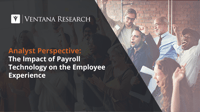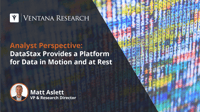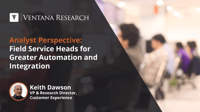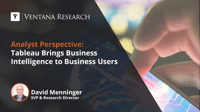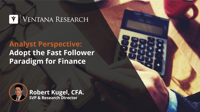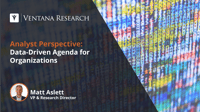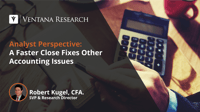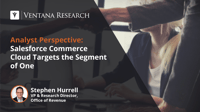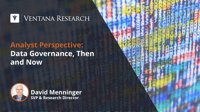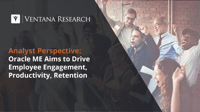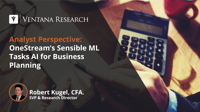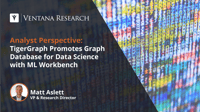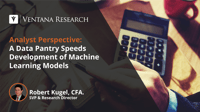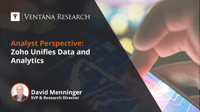I spent years in the talent acquisition space, and I think that at least several months of that time – cumulatively – was spent just trying to get people to calm down. Talent acquisition is a critically important business process, but if I had a dollar for every time I had to remind someone that there really are no recruiting emergencies, I’d be a wealthy woman.
Read More
Topics:
Human Capital Management,
HR technology,
HR/Payroll,
Payroll Management,
employee experience
Streaming data has been part of the industry landscape for decades but has largely been focused on niche applications in segments with the highest real-time data processing and analytics performance requirements, such as financial services and telecommunications. As demand for real-time interactive applications becomes more pervasive, streaming data is becoming a more mainstream pursuit, aided by the proliferation of open-source streaming data and event technologies, which have lowered the cost...
Read More
Topics:
Data,
Streaming Analytics,
Streaming Data & Events,
operational data platforms
Field service is a segment of customer experience that is dominated by two elements: the complexity of the issues handled, and the high cost of providing on-site services. It is recognized as a critical component of the service experience, especially when managing the condition of high-precision equipment in the medical, manufacturing and utility industries. It is also a high-risk moment in the customer life cycle. Consumers often experience the process as a series of disconnected visits and...
Read More
Topics:
Customer Experience,
Voice of the Customer,
Contact Center,
agent management,
Customer Experience Management,
Field Service,
customer service and support
Organizations are collecting vast amounts of data every day, utilizing business intelligence software and data visualization to gain insights and identify patterns and errors in the data. Making sense of these patterns can enable an organization to gain an edge in the marketplace and plan more strategically.
Read More
Topics:
embedded analytics,
Analytics,
Business Intelligence,
AI & Machine Learning
Although the digital transformation of the finance department was a topic of discussion before 2020, it became a front-and-center issue as organizations locked down and in-office interactions became impossible. Finance and accounting departments were immediately confronted with a challenge because of their limited adoption of technology that would support a virtual working environment. As our 2019 Office of Finance Benchmark Research found, they are technological laggards: 45% are at the...
Read More
Topics:
Office of Finance,
Financial Performance Management,
ERP and Continuous Accounting,
digital finance
When joining Ventana Research, I noted that the need to be more data-driven has become a mantra among large and small organizations alike. Data-driven organizations stand to gain competitive advantage, responding faster to worker and customer demands for more innovative, data-rich applications and personalized experiences. Being data-driven is clearly something to aspire to. However, it is also a somewhat vague concept without clear definition. We know data-driven organizations when we see them...
Read More
Topics:
embedded analytics,
Analytics,
Business Intelligence,
Data Governance,
Data Integration,
Data,
Digital Technology,
natural language processing,
data lakes,
data operations,
Digital Business,
Streaming Analytics,
AI & Machine Learning,
data platforms,
Analytics & Data,
Streaming Data & Events
Since its inception 20 years ago, Ventana Research has advocated for a shorter accounting close because it can improve the performance of the entire organization, not just finance and accounting. An important benefit of a shorter close is increased staff time for analysis and the preparation of reports and narratives that improve communications with the board and outside investors. Similarly, the department can provide those in operating roles the financial and managerial accounting results to...
Read More
Topics:
Office of Finance,
Financial Performance Management,
ERP and Continuous Accounting,
digital finance
There are more digital channels in the commerce space than ever before: the web, mobile apps, text, voice-activated “agents,” video and social channels. Conversational computing and hyper-personalization are transforming customer engagement, and organizations may need to undergo a digital platform renovation to optimize customer and product experiences or risk lagging behind competitors. B2B selling and buying are increasingly using methods similar to B2C digital approaches to mirror the...
Read More
Topics:
Digital Commerce,
Office of Revenue
We’ve recently published our latest Benchmark Research on Data Governance and it’s fair to say, “you’ve come a long way, baby.” Many of you reading this weren’t around when that phrase was introduced in 1968 to promote Virginia Slims cigarettes, but you may have heard the phrase because it went on to become a part of popular culture. We’ve learned a lot about cigarettes since then, and we’ve learned a lot about data governance, too.
Read More
Topics:
Big Data,
Data Governance,
Data Management,
Analytics & Data
In my more than two decades in the world of human resources and human capital management technology, I have never seen a topic become so completely ubiquitous so quickly as has employee experience. This is great news from my perspective. As I addressed in this recent analyst perspective, market factors have forced organizations to acknowledge the tremendous bottom-line value of an engaged workforce, and that engagement is wholly dependent upon an employer's commitment to providing a...
Read More
Topics:
Human Capital Management,
employee experience,
Digital Innovation Awards
We conducted our recent Smart Close Dynamic Insights Research in part to assess to what extent the substantial disruptions of the pandemic have impacted the accounting close. When office lockdowns began in the first quarter of 2020, many finance departments were challenged by having to do their quarterly close remotely without their normal face-to-face interactions. In the United States, the Securities and Exchange Commission was so concerned that corporations would be unable to meet their...
Read More
Topics:
Office of Finance,
Financial Performance Management,
ERP and Continuous Accounting,
digital finance
OneStream offers a platform designed to serve the needs of accounting and financial planning and analysis organizations. The software handles financial close and consolidation, planning and budgeting, analysis and reporting. For me, the most significant announcement at the company’s recent user conference was the unveiling of its Sensible ML (Machine Learning) offering, which is in limited general release. I’ve commented on the importance of artificial intelligence in business applications, and...
Read More
Topics:
Business Planning,
Financial Performance Management,
ERP and Continuous Accounting,
digital finance,
AI & Machine Learning,
profitability management
I recently wrote about the growing range of use cases for which NoSQL databases can be considered, given increased breadth and depth of functionality available from providers of the various non-relational data platforms. As I noted, one category of NoSQL databases — graph databases — are inherently suitable for use cases that rely on relationships, such as social media, fraud detection and recommendation engines, since the graph data model represents the entities and values and also the...
Read More
Topics:
business intelligence,
Analytics,
Cloud Computing,
Data,
Digital Technology,
AI & Machine Learning,
data platforms,
Analytics & Data
“Lead to cash” is an often-used term and is a companion to “quote to cash” and “order to cash”. What they all represent is an approach which recognizes that there is a process designed to convert a lead from a qualified interest to an active sale, through quote and contract negotiation, to order or contract, invoice and payment. “Quote to cash” and “order to cash” are subsets of this process, with different starting places, but ultimately end in the same place: with a payment for a delivered...
Read More
Topics:
Revenue Management,
Office of Revenue
A few years ago – somewhat tongue in cheek – I began using the term “data pantry” to describe a type of data store that’s part of a business application platform, created for a specific set of users and use cases. It’s a data pantry because, unlike a general-purpose data store such as a data warehouse, everything the user needs is readily available and easily accessible, with labels that are immediately recognized and understood.
Read More
Topics:
Data Management,
Business Planning,
Financial Performance Management,
ERP and Continuous Accounting,
digital finance,
AI & Machine Learning
Organizations are continuously increasing the use of analytics and business intelligence to turn data into meaningful and actionable insights. Our Analytics and Data Benchmark Research shows some of the benefits of using analytics: Improved efficiency in business processes, improved communication and gaining a competitive edge in the market top the list. With a unified BI system, organizations can have a comprehensive view of all organizational data to better manage processes and identify...
Read More
Topics:
business intelligence,
embedded analytics,
Data Governance,
Data Management,
natural language processing,
data operations,
Streaming Analytics,
AI & Machine Learning,
operational data platforms
